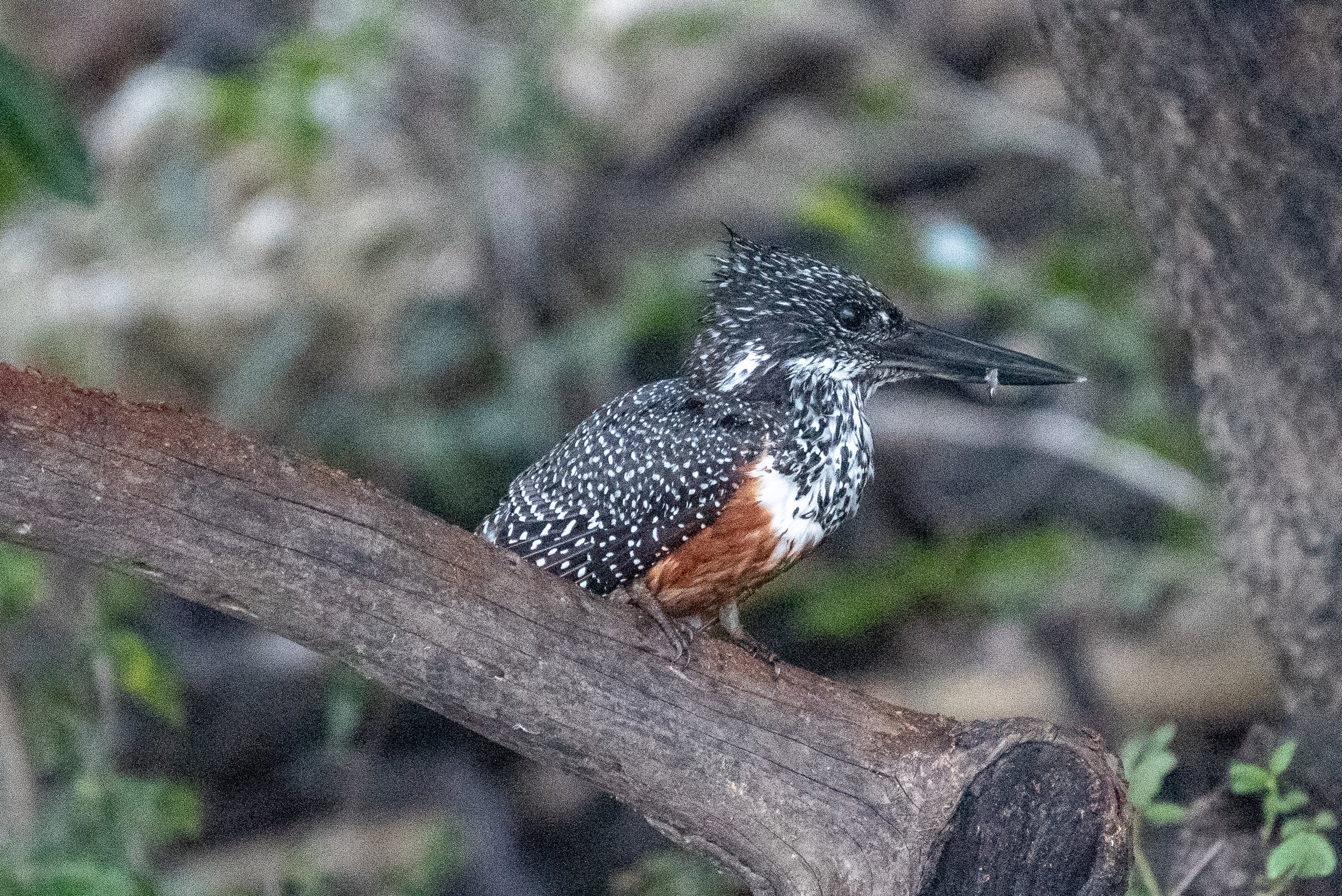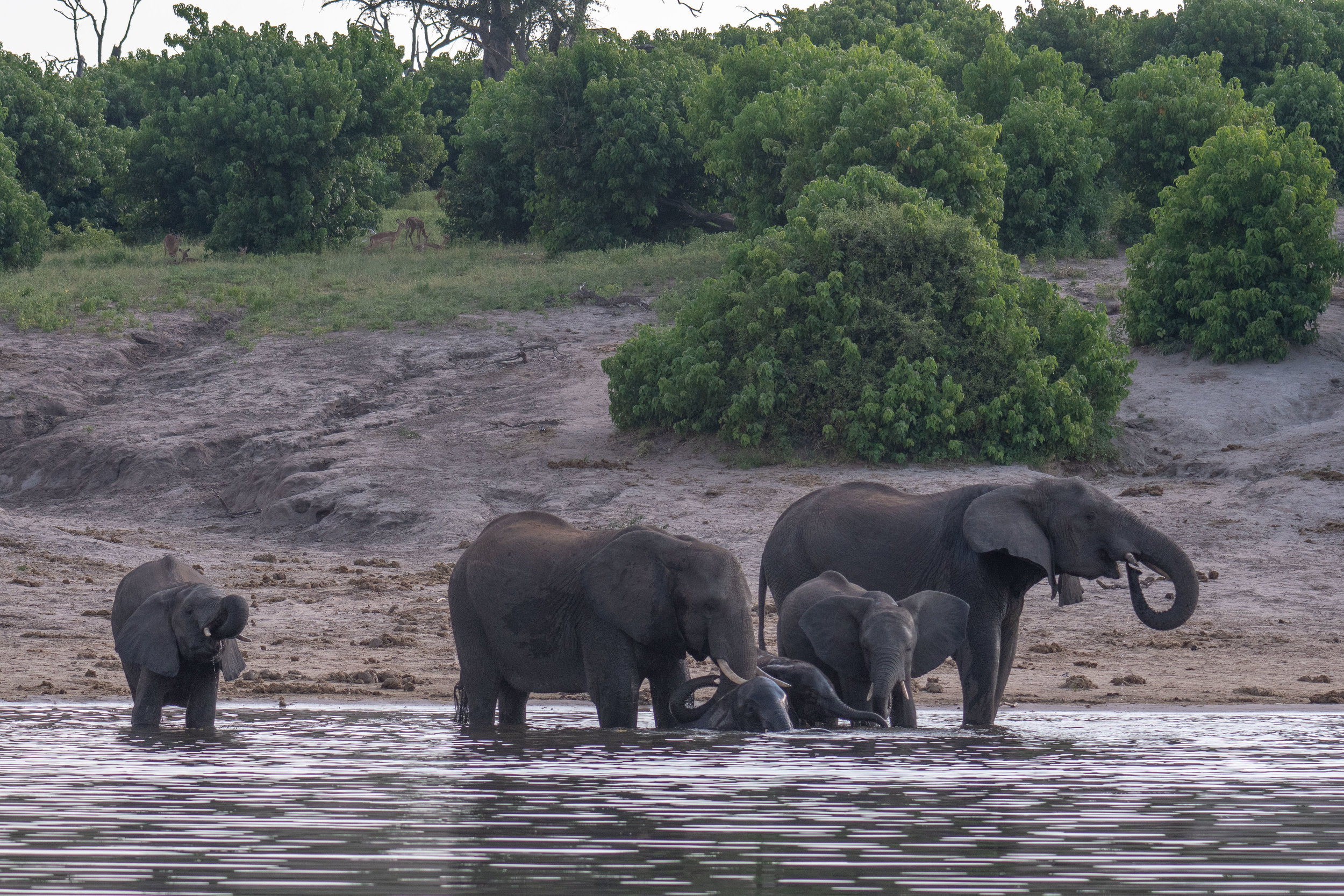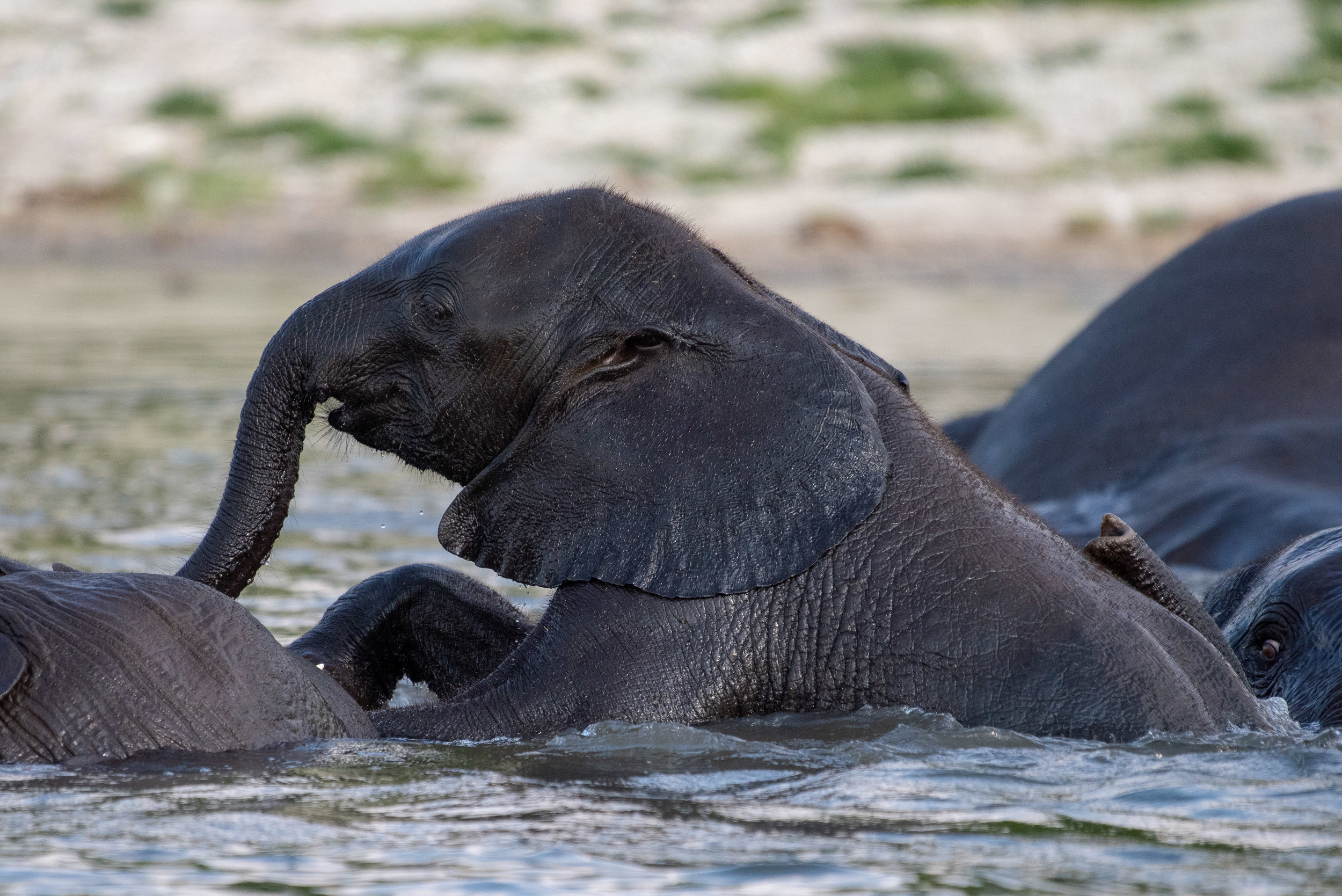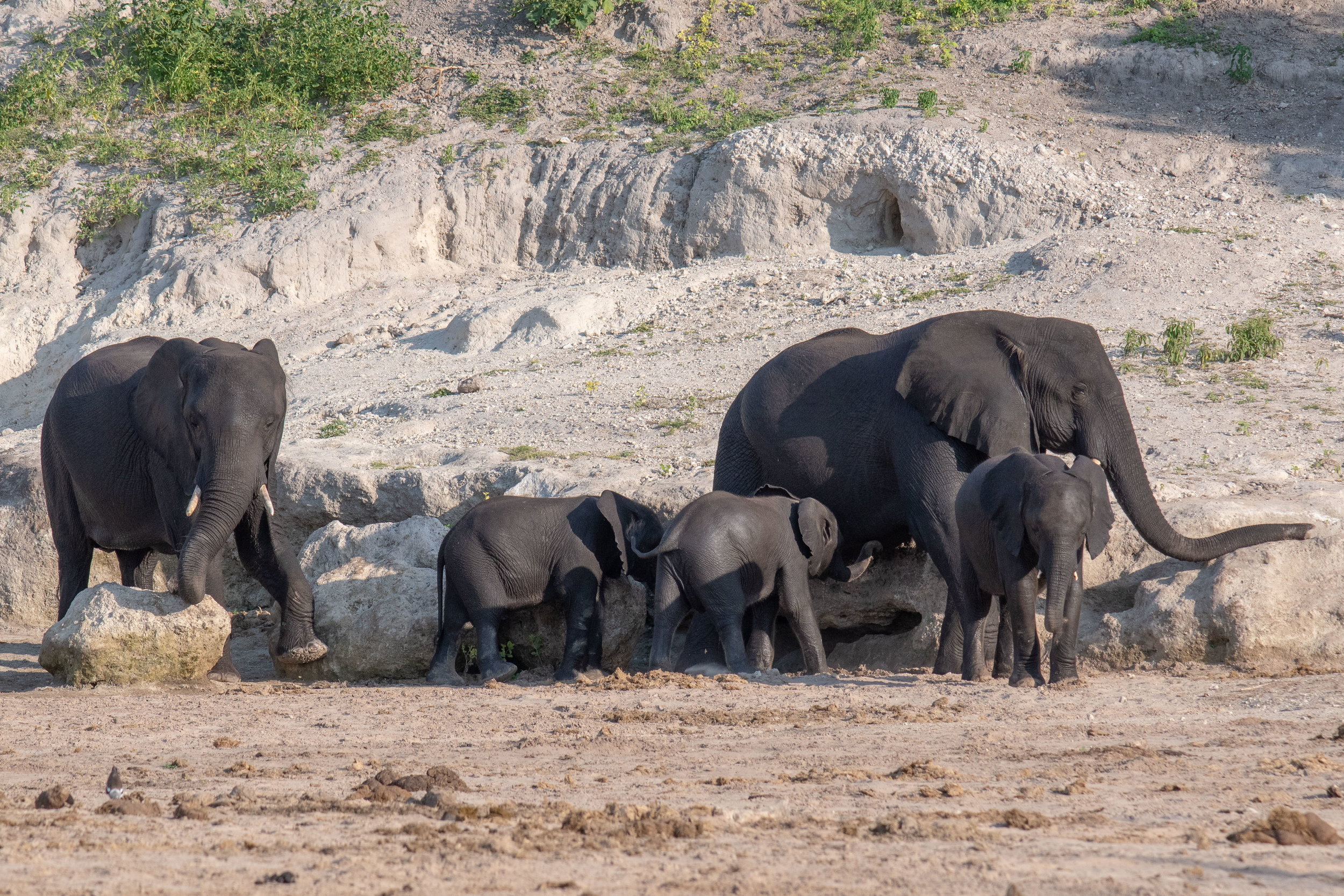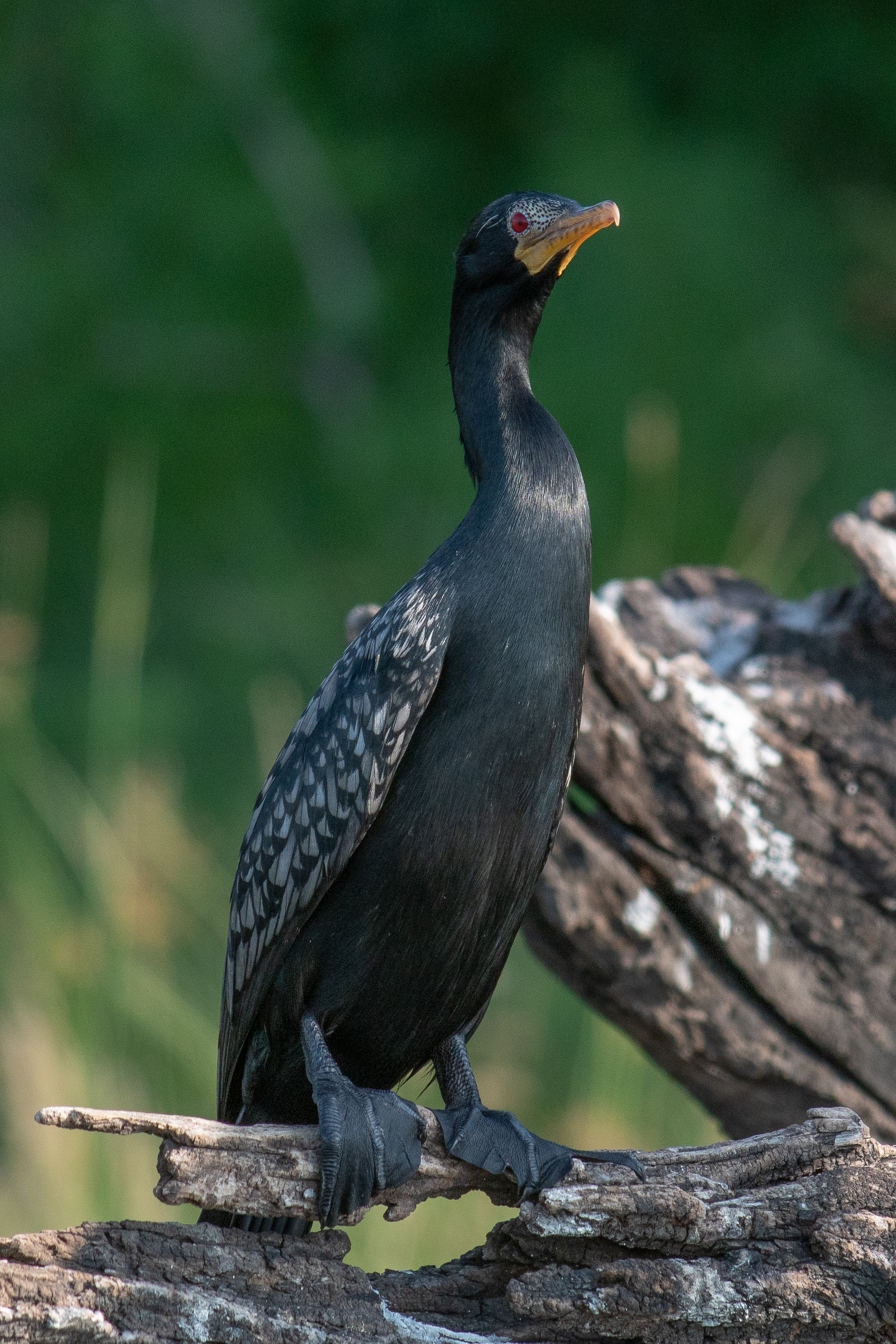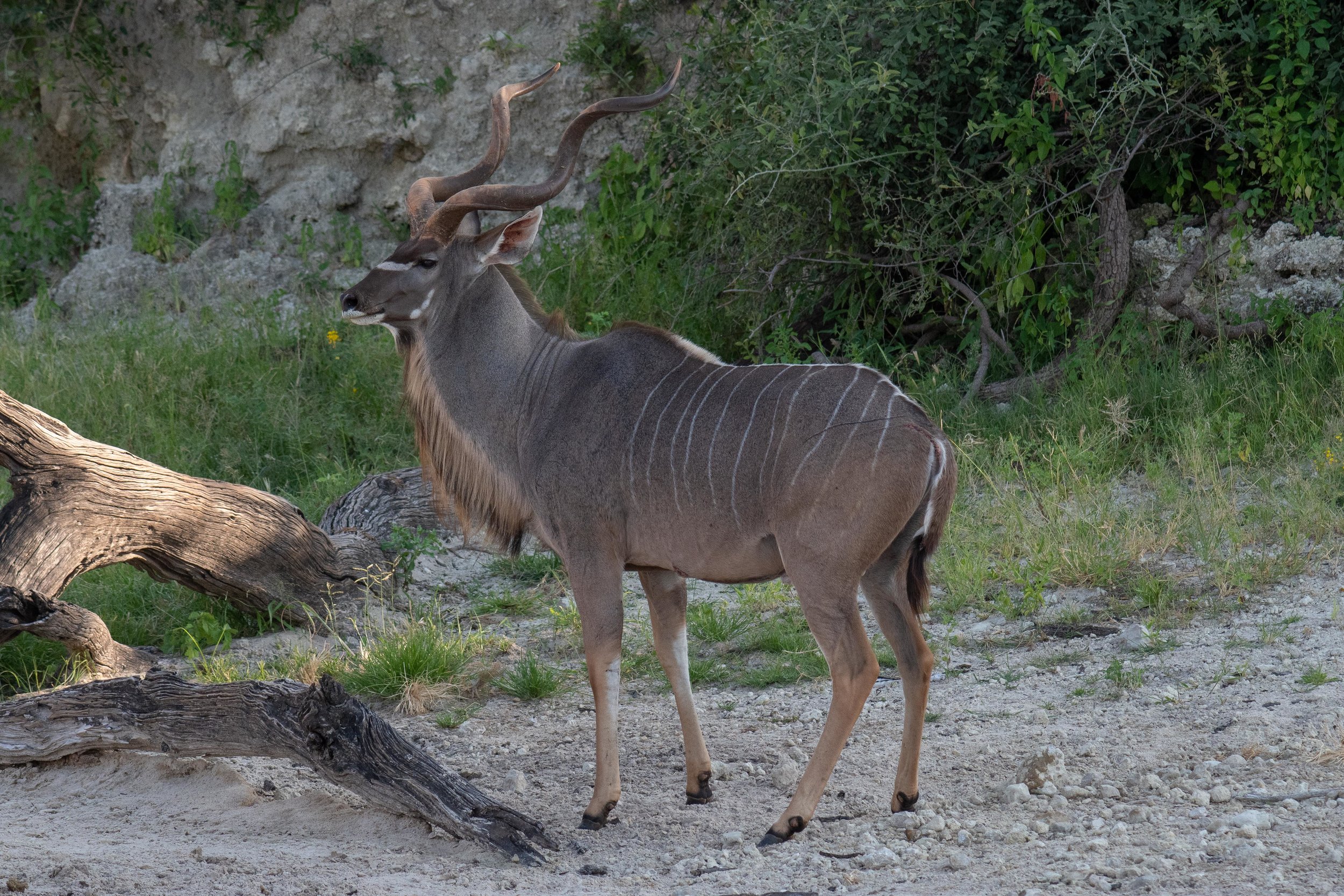There was a minor problem last night with the houseboat’s power supply when the solar battery ran low and no electricity was available until the gen-set was fired up. This resulted in cold/coolish showers in the dark, but no one was concerned although it meant a somewhat latish start to our “dawn” photographic safari.
The first part of our river travels was not particularly productive although many of the ‘usual suspects’ were to be found amongst the river-bank trees and reeds.
Sunrise, Chobe River
Reflections on the Chobe River
Red bishop
African stone-chat (female)
A group of crested guinea fowl were seen wandering along the sandy bank followed by a family of Egyptian geese.
Crested guinea fowl
Egyptian geese family
A pleasing encounter was to find a giant kingfisher with its chestnut breast, whitish underbelly and black spotted wings. They are by far the biggest of the Southern African kingfishers being up to 45 cm in body length whereas malachite kingfishers seldom exceed 14 cm.
Giant kingfisher
The ‘small’ birds seen in this post-dawn period were frequently very shy. Glances of fleeting birds and rushed photos were an unfortunate consequence, and this was particularly the case with blue waxbills, spotted flycatchers, arrow marked babblers, black throated canaries and white browed robin chats.
White-browed robin-chat
Arrow-marked babbler
Black-throated canary
This morning we saw our first grey ‘go-away’ bird in Namibia and this brought back happy memories of these amusing birds outside our unit in Madikwe three years ago.
However, we did manage to get some good photos of coppery-tailed coucals, greater blue-eared starlings and Amur falcons.
Coppery tailed coucal
Greater blue-eared starling
Amur falcon (female)
We managed to get quite close to a small water monitor lizard on a nearby stump.
Water monitor lizard
Water monitor lizard
In a dead tree on the river’s edge we encountered a pair of ox-peckers busy with their nest in a hollow section. A very obliging southern grey headed sparrow stayed on its tree perch even when we were practically touching the tree.
Yellow-billed oxpecker at nest
Southern grey-headed sparrow
Yellow-billed oxpecker
Yellow-billed oxpecker
As a special excursion we headed three or so kilometres up-river and visited a Namibian village called Jambwe.
The village has been in its river-bank location for 300 years and has a population of about 60. The villagers are subsistence farmers and fishers. The surrounding flood plain land is rich in alluvial loam and the climate allows two or three crops a year. The main crops produced being maize and vegetables such as pumpkins. This is supplemented by fishing, dairy cattle and poultry production. The cows are milked just once a day.
Pangolin photo boat at Jambwe village
Jambwe village
Most houses are mud walled with thatched roofs. Married couples have a bamboo fence around the house to protect it from the wind as cooking in dry weather is done on open braziers in the outside yard.
Jambwe village house
Jambwe village house
Locals only marry people from other nearby villages with inter-marriage within the village community being taboo. Men typically have two wives although five is possible but requires a separate house for each wife. Families of up to nine children were previously known but the greater influence of 21st century living has made education and family welfare an issue and now smaller families are more common. Solar panels and mobile phones provide an interesting juxtaposition within a seemingly ancient cultural setting.
Solar system for pumping water
Cooking facilities
We were surprised to note that a considerable number of trees within the village were eucalypts, with the leaves being of some medical use. A prominent and very large baobab tree in the centre of the village was referred to by the locals as their ‘tree of life’ and it played a prominent role when celebrating the arrival of a new baby to the village. Pieces of green stick taken from another smaller tree growing near the river were used by the local for cleaning teeth.
Eucalypt, Jambwe village
Village scene
Baobab (Tree of Life)
Sausage tree
Catholicism and Seventh Day Adventism form a strong cornerstone of life within the village.
Children are all vaccinated and free, compulsory education occurs for children up to the end of primary school. An increasing number of students are now continuing through to secondary and even tertiary levels.
Jambwe village
At the end of our visit we were ushered into a bamboo encircled courtyard and were entertained by the village people with dancing, singing and drumming. Souvenirs were on sale and we bought some wooden and beaded items and we also made a financial donation to the village.
Village people entertaining us
On our return trip to our houseboat we stopped to photograph a pod of hippos including some tiny babies. Nearby were a dozen or so warthogs foraging along the grassy bank. These unattractive hogs have an amusing defence trait of extending their thin but long tails vertically (like an aerial) to warn of nearby predators, especially lions!
Hippos with baby
Wart hogs
After brunch the houseboat moved back down the Chobe River to the point where we embarked three days ago. We are now back in sight of Kasane with Botswana being the country on the distant riverbank.
lephants plus Often-spotted Landcruiser viewed from Pangolin Voyager
The afternoon’s session started at 16:00 with us heading back up the Chobe River to the mid river island where elephants and hippopotamuses were in great numbers.
A very large and presumably senior bull elephant was feeding near the water’s edge and was pulling tufts of grass from water and swishing it backwards and forwards to get the mud and sand off the roots. Male elephants when displaying dominance or when sexually aroused are pretty easy to recognise. As we were informed, “a five-legged elephant is a bull elephant!”
Bull elephant
Bull elephant
A little further on was a herd of about twenty elephants of all ages and sizes. They were bathing and cavorting in about two metres of water. There appeared to be games occurring amongst the younger calves with pushing and ducking being fun activities. Adults can take in as much as 80 litres of water per trunk full and need up to 140 litres per day. They can survive for only one or possibly two days without water. Their capacity to find and to dig for water enables then to survive in semi-arid regions for short periods.
Elephants bathing and cavorting
Elephants bathing and cavorting
Elephants bathing and cavorting
Elephants bathing and cavorting
Elephants licking rocks
Elephants and warthogs
A large hippo on the bank didn’t appreciate our proximity and made a dramatic rush across 20m of land and dived into the water and headed straight for us. This act of aggression is often seen and the tour operators are very wary of this behaviour. A large hippo could easily tip over a small boat even with passengers on board. You’d then be at the mercy of not only the hippos but the crocodiles that abound in these waters.
Aggressive hippo on bank
Aggressive hippo next to our boat
We managed to get good photos of the grey capped kingfisher; a bird that we’d spotted yesterday but it was in a near impossible position to photograph.
Grey capped kingfisher
Common sandpiper
Emerald-spotted wood dove
Along the riverbank we had frequent sightings of reed cormorants, African darters, sand pipers, egrets and herons.
Reed cormorant
Reed cormorant
African Darter, Chobe River, Namibia, 4 Mar 2019-2
Green-backed heron
Green-backed heron
A large male kudu made an appearance at the water’s edge but was very sensibly wary of entering the water as close-by a reasonably large crocodile lay in wait.
Kudu
Kudu & crocodiles
We had the opportunity of seeing a mother hippo feeding her calf and the process is more complex that one might suppose. As the hippo cow’s legs are too short to make the teats readily accessible for her calf, she feeds the calf in the water. In so doing, she submerges and lies on her side in a similar way that sows feed their piglets. She can stay submerged for six or more minutes so the feeding process works well even if the calf comes to the surface quite often during the process.
Mother hippo
The last part of the evening’s activities was spent taking sunset photos. The rich fire coloured ball of the sun disappeared leading to a beautifully pink sky with red tinged clouds. This provided a perfect way to end our day of photographing the glorious scenery and wildlife of Namibia.
As per previous days on board the Pangolin Voyager, after returning to the houseboat and freshening up we were treated to pre-dinner drinks and a sumptuous three-course meal prepared by Melody. Tonight’s meal consisted of cold cucumber soup, pork casserole with rice and vegetables and a pastry with frozen yoghurt and berries, Delectable!







